Crew 16 – Assigned 752nd Squadron – October 1943
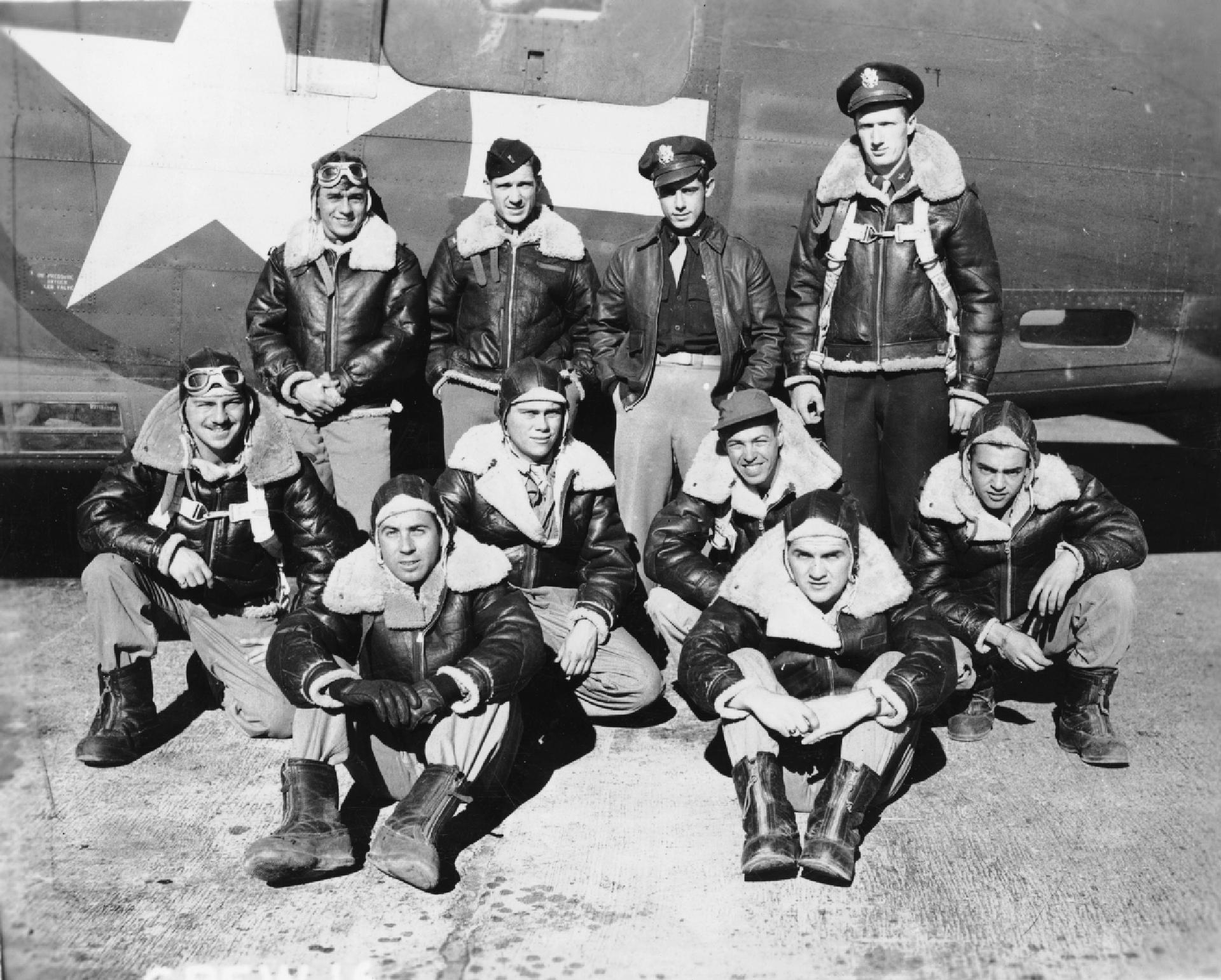
Front Row: Unidentified, Joe Conowall – RO
Crew 16 – Completed Tour
| Rank | Name | Serial # | Pos | Date | Status | Comments |
|---|---|---|---|---|---|---|
| 1Lt | Edwin A Grant | 0733877 | Pilot | 29-Apr-44 | INT | Reported shot down - landed Sweden |
| Lt | Paul M Stout | 0756350 | Co-pilot | Jun-44 | CT | Awards - Distinguished Flying Cross |
| 1Lt | Julius Gross | 0811547 | Navigator | Jul-44 | CT | Awards - Distinguished Flying Cross |
| 1Lt | Edward C Gibbons | 0688959 | Bombardier | Jul-44 | CT | Awards - Distinguished Flying Cross |
| T/Sgt | Joseph Conowall | 13027657 | Radio Operator | Jun-44 | CT | Awards - Distinguished Flying Cross |
| T/Sgt | Wilbert L Grote | 18061790 | Flight Engineer | Aug-44 | CT | Awards - Distinguished Flying Cross |
| S/Sgt | Gene R Groll | 15354321 | Armorer Gunner | Jun-44 | CT | Awards - Distinguished Flying Cross |
| S/Sgt | Elvin C Detisch | 33032300 | Armorer-Gunner/2E | Jun-44 | CT | Awards - Distinguished Flying Cross |
| S/Sgt | Melvin A Gershun | 16127090 | Aerial Gunner/2E | Aug-44 | CT | Awards - Distinguished Flying Cross |
| S/Sgt | John W Davis | 18165615 | Armorer-Gunner | 26-Apr-45 | CT | Suspended fr flying AAF Reg 35-16 |
It is not exactly clear when Lt Grant and crew became part of the752nd Squadron. They are listed as Crew 16 on the Combat Crew Roster, however they are the second crew to be labeled as such. The first, commanded by pilot 2Lt Sigmund B. Hons, crashed shortly after takeoff on November 16, 1943 during a training flight at Tonopah. Out of this ten man crew, only the flight engineer survived.
2Lt Dick A. Hill was originally assigned as the pilot of this crew with 2Lt Robert E. Reddish as co-pilot, and Sgt Vincent Gould as flight engineer. At some point during training, the two officers were replaced by 2Lt Edwin A. Grant as pilot and 2Lt Paul M. Stout as co-pilot. On December 29, 1943, just as the 458th was receiving their new B-24’s for movement overseas, Lt’s Hill and Reddish were transferred to the 470th Bombardment Group at Mountain Home, Idaho. Dick Hill went on to fly with the 5th Air Force in the Pacific Theater. Assigned to the 64th Bombardment Squadron, 43rd Bombardment Group, he flew 60 combat missions. Nothing further is known on Reddish.
Sgt Vincent Gould also flew in the Pacific with the 320th Bomb Squadron, 90th Bomb Group Jolly Rogers. It is possible that he was replaced by Sgt Elvin C. Detisch, who appears on a set of orders with other Crew 16 enlisted men, and several loading lists for Grant’s early missions.
Sgt Melvin A. Gershun, gunner, appears to have been moved to another crew after the group moved to England. He is not listed flying with Grant on available loading lists, but he does appear with Lt Richard W. Nyman (Crew 11), and on April 29, 1944 was on Lt Milton P. Schaaf’s ship when they cracked up on landing. Sgt John W. Davis appears to have flown several early missions with Grant, but his name is not with those others on Crew 16 who completed their tour in the summer of 1944. He may have been wounded or reassigned, for his name appears on group records in January 1945 (Air Crew Leave) and in April 1945 (removed from flying status). Two gunners from the disbanded Crew #12, Sgt Charles B. Burton and Sgt Edward R. Worrell are pictured with the rest of the crew during mid-March, and may have flown several missions with Grant.
It was rare for one crew to fly the same ship on all of their missions, but it appears that Grant’s crew somehow managed to maintain their claim on the B-24 “WURF’LESS” for their first 13 missions. They might have taken it further if the ship hadn’t have been lost on April 18th near Brandenburg, Germany with the crew of Lt George W. Schuman. Nine of these 13 missions were to German targets, while the remainder involved missions to France.
On April 29, 1944, Crew 16 was stood down from the day’s mission. Lt Grant, however, was slated to fly as an Instructor Pilot (I.P.) for the newly arrived crew of Lt Dale R. Morris. The 458th put 29 Liberators into the air. Of these, six aircraft aborted and the remaining 23, including Grant and Morris made it to the target. For reasons unknown, Morris’ crew had arrived at the 458th without a navigator, and filling in on this mission was 2Lt William C. Lane. Lane had been the navigator on the above mentioned Lt Beckley’s Crew 12 before Beckley became ill during training and the crew was dispersed throughout the 752nd.
Related by Grant, the trouble started for the crew, “over the city of Berlin, seconds before bombs away….” According to the Missing Air Crew Report (MACR 4451): “Morris was seen to be attacked by FW-190s at 1104 hours in vicinity of Celle, Germany. One engine was knocked out and A/C fell out of formation in an easy spin. Four (4) ‘chutes were seen before A/C disappeared into clouds below.” No one had in fact bailed out, as Ed Grant related in the MACR that the, “aircraft landed in Sweden with all crew members aboard.”
After Grant’s unscheduled departure, co-pilot Paul M. Stout with 12 missions from the right-hand seat, took over as pilot of Crew 16. It is not known if they were assigned a regular co-pilot. Lt Stout brought the crew through the remainder of their missions, completing their combat tour in early June 1944. Seeming to keep with crew tradition, Stout flew 15 of his 18 missions in the same aircraft, Gas House Mouse. The majority of the crew were awarded the Distinguished Flying Cross in July and sent to other assignments.
Lt Paul Stout returned to the U.S. and eventually was stationed at Randolph Filed, Texas. It was here, on June 12, 1945, just one year after completing his tour of missions in Europe, that he was killed while the co-pilot on a B-29.
Missions – 1Lt Ed Grant Pilot
| Date | Target | 458th Msn | Pilot Msn | Serial | RCL | Sqdn | A/C Msn | A/C Name | Comments |
|---|---|---|---|---|---|---|---|---|---|
| 25-Feb-44 | DUTCH COAST | D2 | -- | 42-52382 | -- | 7V | D2 | WURF'LESS | Diversion Mission |
| 02-Mar-44 | FRANKFURT | 1 | 1 | 42-52382 | J | 7V | 1 | WURF'LESS | |
| 05-Mar-44 | BORDEAUX/MERIGNAC | 3 | 2 | 42-52382 | J | 7V | 2 | WURF'LESS | |
| 08-Mar-44 | BERLIN/ERKNER | 5 | 3 | 42-52382 | J | 7V | 3 | WURF'LESS | |
| 09-Mar-44 | BRANDENBURG | 6 | 4 | 42-52382 | J | 7V | 4 | WURF'LESS | |
| 15-Mar-44 | BRUNSWICK | 7 | 5 | 42-52382 | J | 7V | 5 | WURF'LESS | |
| 16-Mar-44 | FRIEDRICHSHAFEN | 8 | 6 | 42-52382 | J | 7V | 6 | WURF'LESS | |
| 18-Mar-44 | FRIEDRICHSHAFEN | 9 | 7 | 42-52382 | J | 7V | 7 | WURF'LESS | |
| 22-Mar-44 | BERLIN | 11 | 8 | 42-52382 | J | 7V | 9 | WURF'LESS | |
| 23-Mar-44 | OSNABRUCK | 12 | 9 | 42-52382 | J | 7V | 10 | WURF'LESS | |
| 24-Mar-44 | ST. DIZIER | 13 | 10 | 42-52382 | J | 7V | 11 | WURF'LESS | |
| 26-Mar-44 | BONNIERES | 14 | 11 | 42-52382 | J | 7V | 12 | WURF'LESS | |
| 08-Apr-44 | BRUNSWICK/WAGGUM | 17 | 12 | 42-52382 | J | 7V | 14 | WURF'LESS | |
| 09-Apr-44 | TUTOW A/F | 18 | NTO | 42-52382 | J | 7V | -- | WURF'LESS | NO TAKE OFF - #4 STARTER |
| 10-Apr-44 | BOURGES A/F | 19 | 13 | 42-52382 | J | 7V | 15 | WURF'LESS | |
| 11-Apr-44 | OSCHERSLEBEN | 20 | 14 | 42-52382 | J | 7V | 16 | WURF'LESS | |
| 12-Apr-44 | OSCHERSLEBEN | REC | -- | 42-52382 | J | 7V | -- | WURF'LESS | RECALL |
| 29-Apr-44 | BERLIN | 31 | 15 | 41-28718 | M | 7V | 27 | BO | PILOT D. MORRIS - SWITZERLAND |
B-24H-15-FO 42-52382 Wurf’less – mid-March 1944
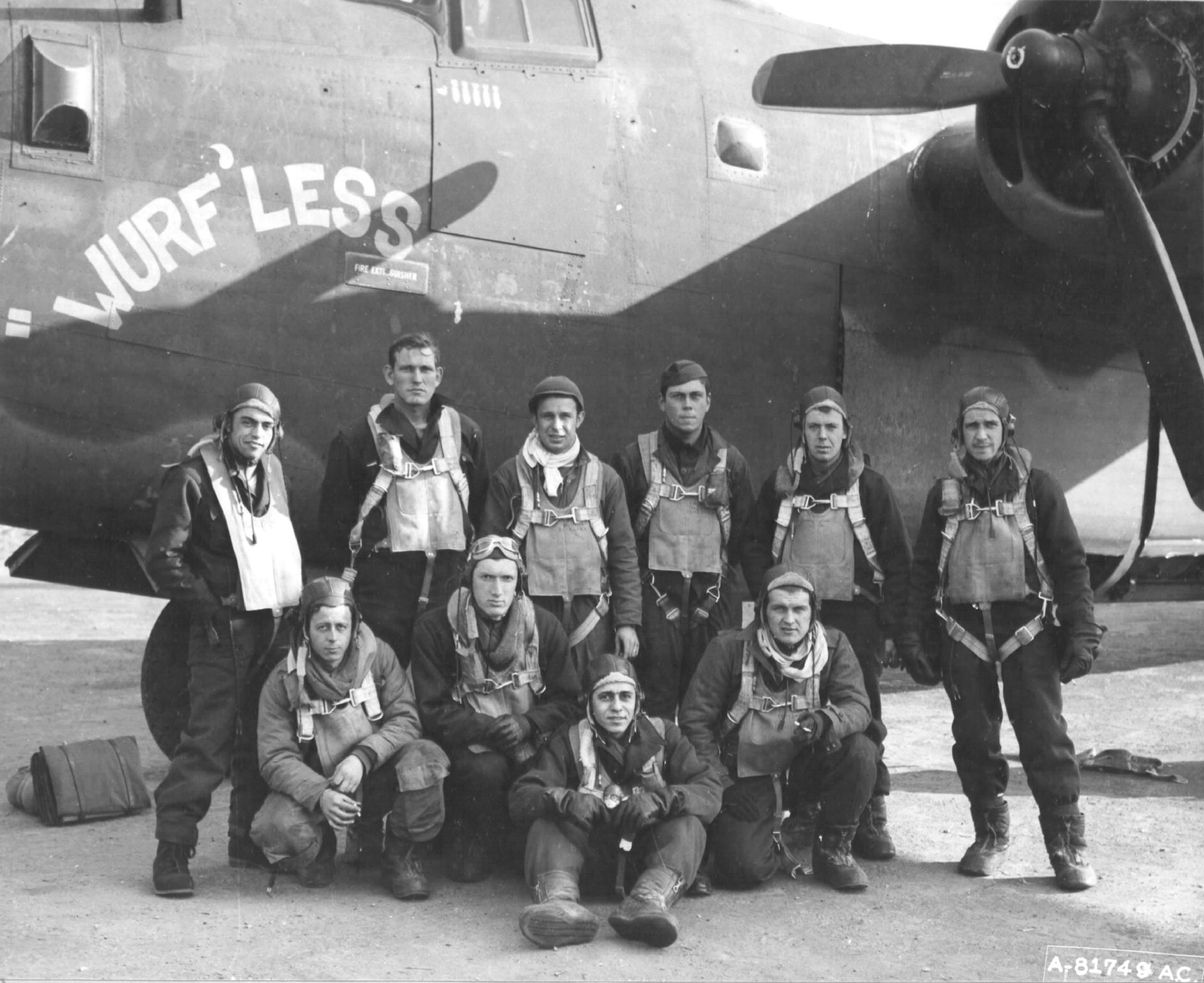
(Photo: Gene Groll)
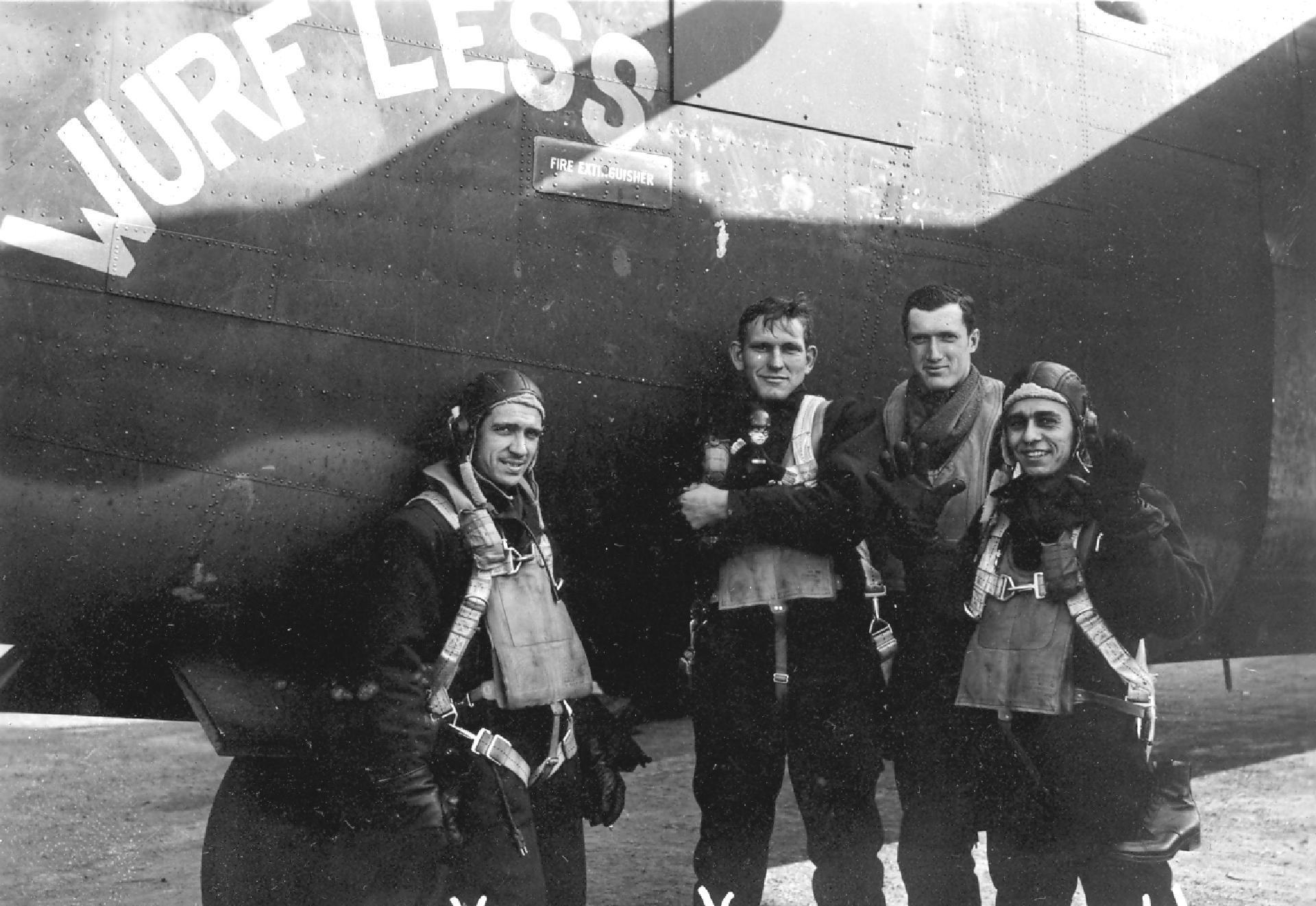
Ed Grant, Paul Stout, Ed Gibbons, Jay Gross
Co-pilot Paul Stout holds what appears to be the crew’s good luck mascot, while navigator Jay Gross holds up 10 fingers. This photo appears to have been taken at the same time as the one above, judging by the crew’s apparel and the shadows on the aircraft. Five mission symbols on the aircraft would date this photo mid-March when the crew would have only completed about 6 or 7 missions, so Gross’ figure may be wishful thinking!
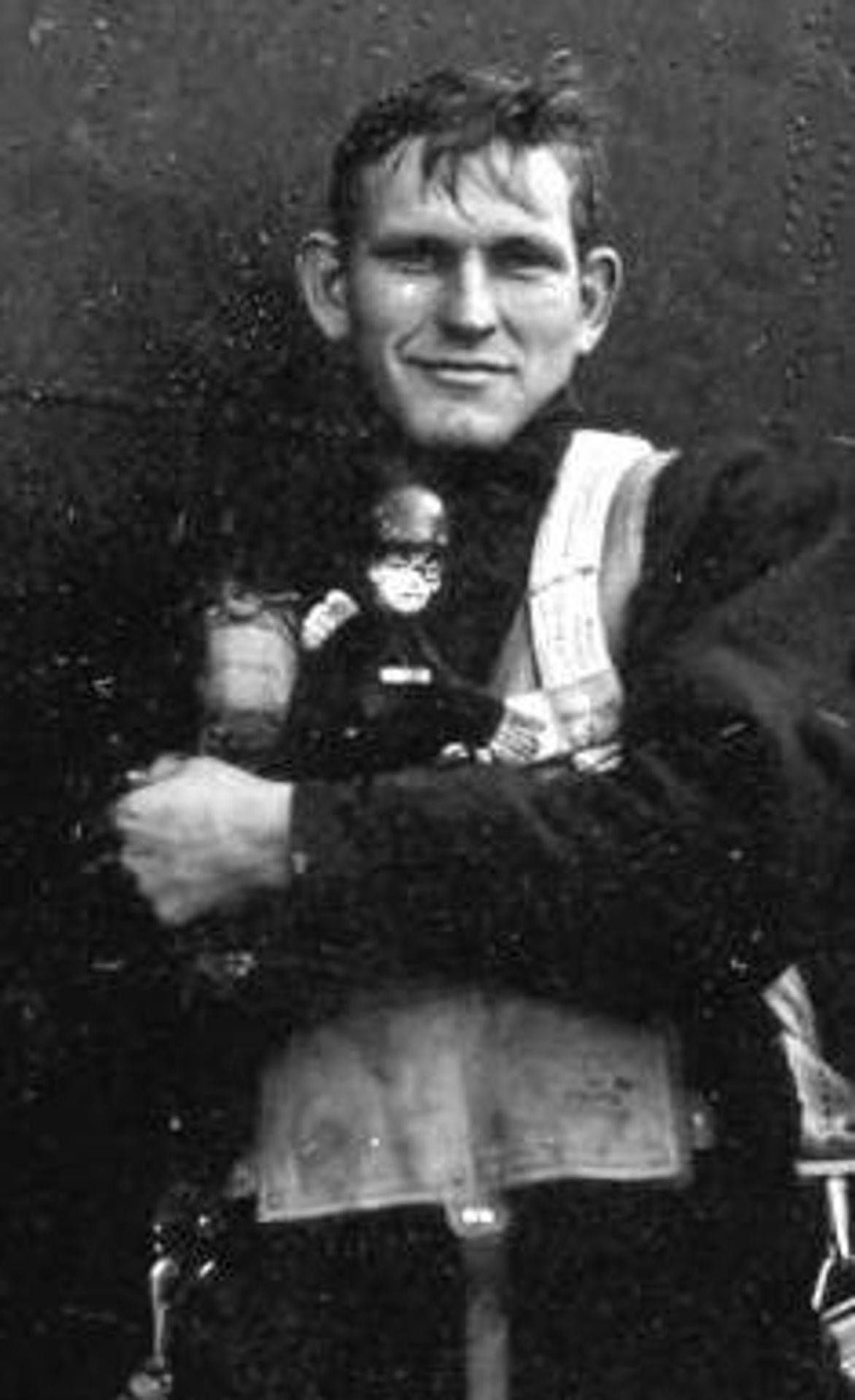
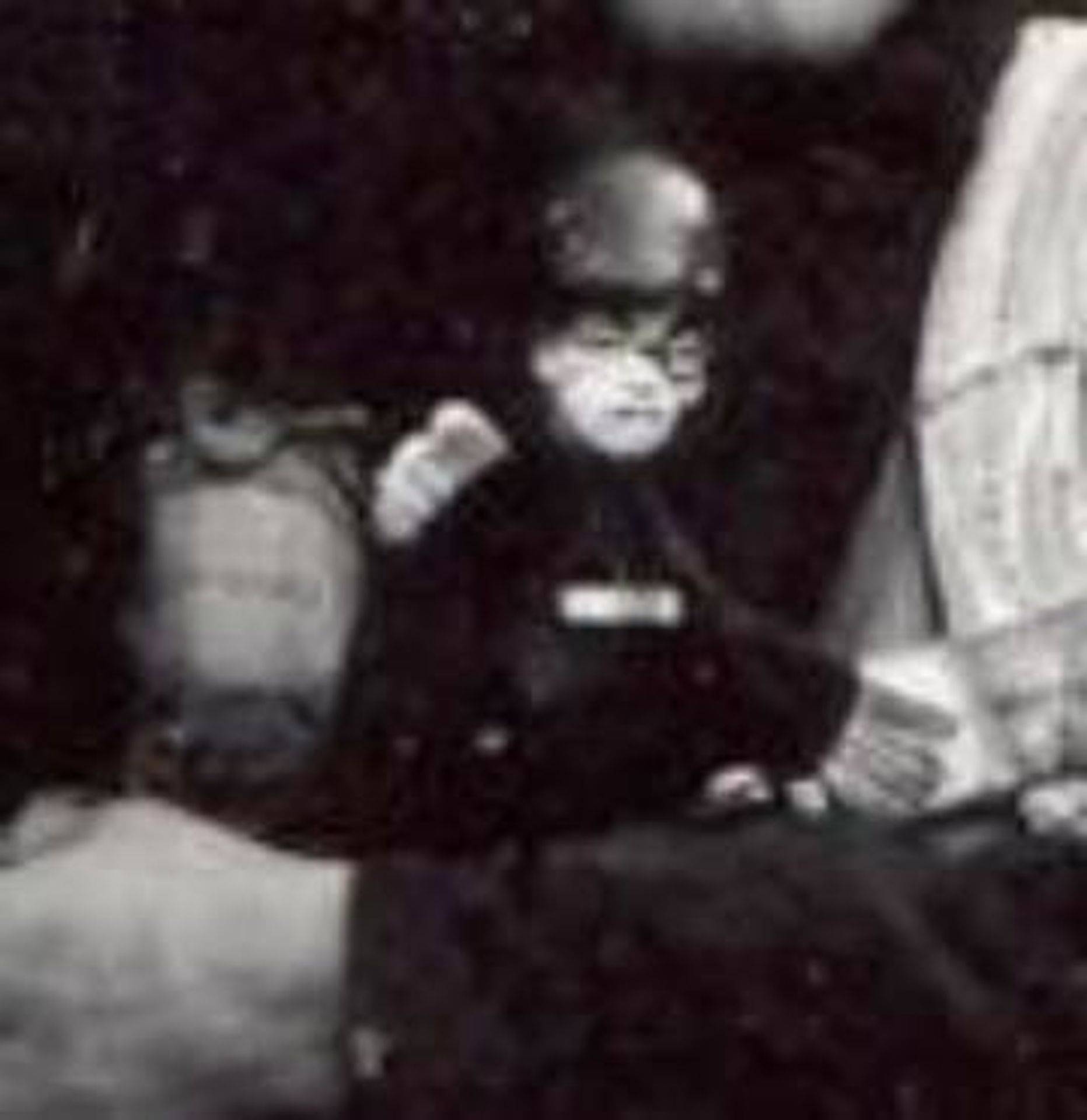
Paul Stout took over duties as pilot when Ed Grant was force to Switzerland with another crew
(Photo courtesy: Bayard Wilson via James Payne)
Missions – 1Lt Paul M. Stout – Pilot
| Date | Target | 458th Msn | Pilot Msn | Serial | RCL | Sqdn | A/C Msn | A/C Name | Comments |
|---|---|---|---|---|---|---|---|---|---|
| 04-May-44 | BRUNSWICK/WAGGUM | 34 | 1 | 42-50314 | L | 7V | 1 | ETO PLAYHOUSE | |
| 05-May-44 | SOTTEVAST | 35 | 2 | 42-52455 | O | 7V | 23 | PLUTOCRAT | GORRELL INSTRUCTOR PILOT |
| 07-May-44 | OSNABRUCK | 36 | 3 | 42-95050 | J | 7V | 3 | GAS HOUSE MOUSE | |
| 08-May-44 | BRUNSWICK | 37 | 4 | 42-95050 | J | 7V | 4 | GAS HOUSE MOUSE | |
| 09-May-44 | ST. TROND | 38 | 5 | 42-95050 | J | 7V | 5 | GAS HOUSE MOUSE | |
| 10-May-44 | DIEPHOLZ | REC | -- | 42-95050 | J | 7V | -- | GAS HOUSE MOUSE | RECALL BEFORE EC |
| 11-May-44 | EPINAL | 39 | 6 | 42-95050 | J | 7V | 6 | GAS HOUSE MOUSE | |
| 13-May-44 | TUTOW A/F | 41 | 7 | 42-95050 | J | 7V | 7 | GAS HOUSE MOUSE | |
| 20-May-44 | RHEIMS A/D | 43 | 8 | 42-95050 | J | 7V | 8 | GAS HOUSE MOUSE | |
| 21-May-44 | SIRACOURT | 44 | 9 | 42-95050 | J | 7V | 9 | GAS HOUSE MOUSE | |
| 23-May-44 | BOURGES | 45 | 10 | 42-95050 | J | 7V | 10 | GAS HOUSE MOUSE | |
| 24-May-44 | VILLEROCHE, near MELUN | 46 | 11 | 42-95050 | J | 7V | 11 | GAS HOUSE MOUSE | |
| 25-May-44 | MULHOUSE M/Y | 47 | 12 | 42-95050 | J | 7V | 12 | GAS HOUSE MOUSE | |
| 27-May-44 | NEUNKIRCHEN | 48 | 13 | 42-95050 | J | 7V | 13 | GAS HOUSE MOUSE | |
| 29-May-44 | TUTOW A/F | 50 | 14 | 42-95050 | J | 7V | 14 | GAS HOUSE MOUSE | |
| 30-May-44 | ZWISCHENAHN A/F | 51 | 15 | 42-95050 | J | 7V | 15 | GAS HOUSE MOUSE | |
| 31-May-44 | BERTRIX | 52 | 16 | 42-95050 | J | 7V | 16 | GAS HOUSE MOUSE | |
| 02-Jun-44 | STELLA/PLAGE | 53 | 17 | 41-28709 | I | 7V | 17 | LUCKY STRIKE |
B-24H-25-FO 42-95050 7V J Gas House Mouse
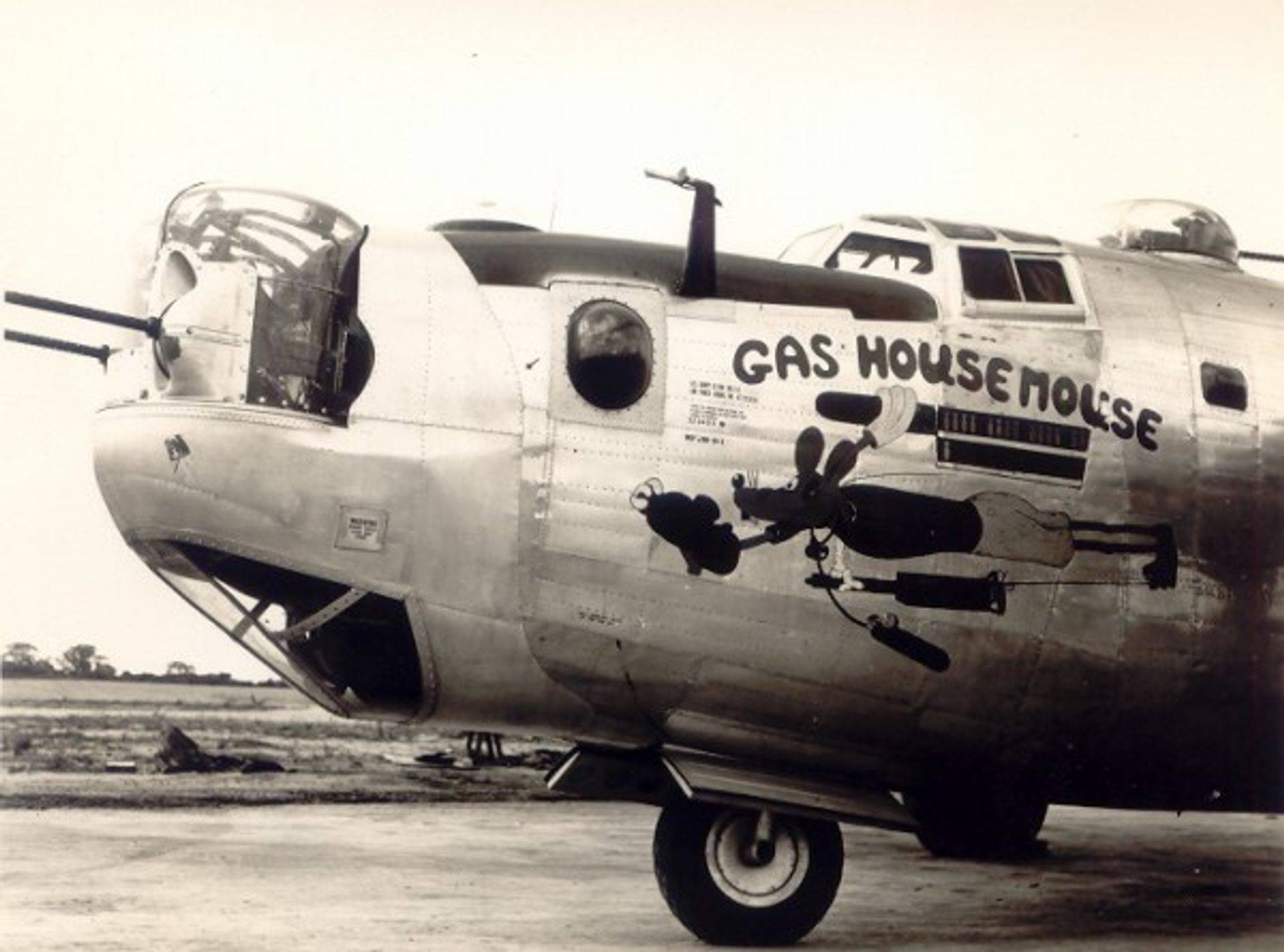
Crew 16, under Paul Stout, flew this aircraft on 14 of their final 17 missions
(Photo: Mike Bailey)
Interview with J. Gross – 2003
June 12, 1945 – Randolph Field, Texas
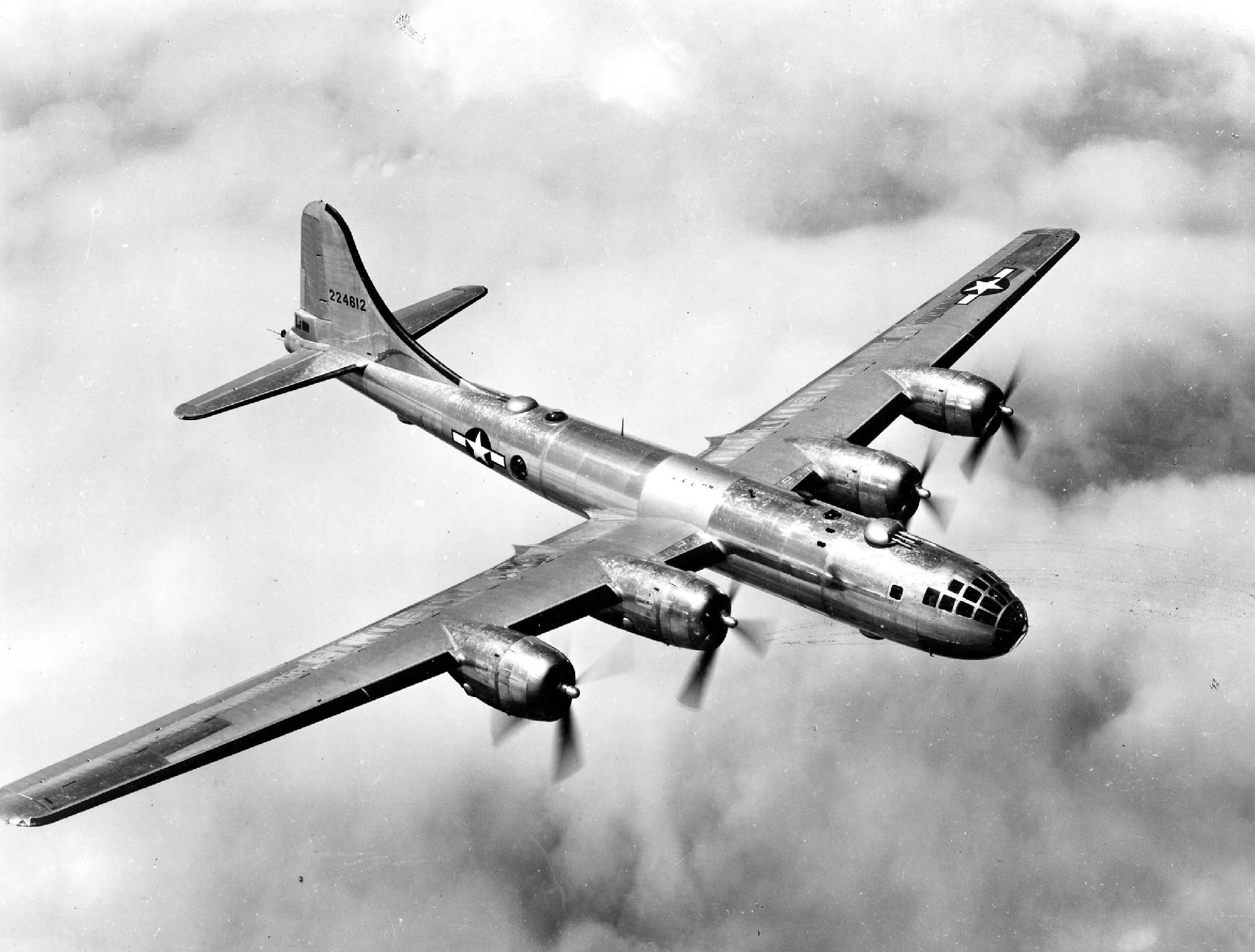
B-29 Superfortress similar to the aircraft Stout was flying
DESCRIPTION OF ACCIDENT – TB-29A No 42-93827 (Accident Report 45-6-12-1)
Captain Johnson, pilot, and Lt Stout, co-pilot, with a crew of 5 took off from Randolph Field at approximately 2150 CWT, 12 June 1945, on a night training mission. The airplane crashed and burned 10 miles northeast of Randolph Field at 2230 CWT. The airplane struck the ground headed east, nose down, a little past the vertical. No reason could be found for the airplane’s striking the ground in this attitude. The airplane was completely demolished from the impact, scattering parts of the wings, fuel tanks and tail group over an area of approximately a 100-yard radius. All occupants were killed as a result of the crash. The right stabilizer was about 45 feet east of the airplane and the left stabilizer approximately 150 feet northwest of the airplane. These stabilizers broke at approximately station 168 and from the bends of the rear spar it is believed they broke off when the airplane struck the ground. The part of the right stabilizer that was east of the airplane had practically all the bottom skin torn off. The flap screw indicated no flaps down. It is believed that the airplane caught fire upon impact, since witnesses reported seeing no fire while the plane was in the air.
SUPPLEMENT TO SECTION L
No copies of Forms 1 and 1A attached because these forms were destroyed by fire at the time of the accident.
This aircraft made 3 flights of approximately 5 hours duration on 12 June 1945. The pilot of the first flight was Major Askounis, Aircraft Maintenance Officer for VHB at this Station, who flew this aircraft 1:20 slow timing #3 engine, which had been changed the day before. This aircraft was given a thorough check, both in engine operation and flight characteristics and no unusual condition or characteristics were noted. On the second flight, Lt. Claude C. Martin and crew flew the aircraft on a routine training flight, during which no unusual conditions or characteristics were noted. This flight was 3:10. Immediately upon return from the second flight, the crew which crashed with the aircraft took off. During this last flight nothing was reported by radio to indicate any unusual condition.
————-
Crash located approximately 11 miles by road from Randolph Field. Roads to crash are hard surface and gravel. Terrain in vicinity of crash is level. Crash and fire trucks had to cross muddy cotton filed. Crash and fire trucks arrived at scene of accident 20 minutes after leaving Randolph Field.
Aircraft was not on fire before it crashed. Fire stared immediately upon impact with the ground. Its origin is unknown, [sic]. The fire was fed by gasoline and oil in the area, plus magnesium in the aircraft structure.
Crash and fire crews arrived at the scene of the crash 35 minutes after the crash. Crews were sent out in No. 125 crash trucks. One truck bogged down in the muddy field and had to back out and the other truck did not go in due to the mud and the fact that the fire was burning in the hole and obviously no rescue could be made. No effort was made to extinguish the fire until the next afternoon when they were able to extinguish all fire except that in No. 2 engine, which was still smoldering 80 hours later due to hot metal and oil. 6600 gallons of water were used in extinguishing the fire. The aircraft and engines were completely burned.
Personnel were killed upon impact of the airplane with the ground. No rescue was attempted until the aircraft had cooled of as the aircraft was a complete wreck and obviously all personnel were dead.
/Signed/
Henry H. Reeves
Major, Air Corps
Aircraft Accident Officer
Civilian Statements
RANDOLPH FIELD )
COUNTY OF PEXAR )
STATE OF TEXAS )
Personally appeared before me the undersigned authority for administering oaths, one Charlie Hoffman, Route 1, Marion, Texas, who being duly sworn deposes and says:
I live about 3/4 of a mile west of the scene of the accident of a B-29 types airplane on the night of 12 June 1945. I had just walked out on the back porch when I heard a big plane coming and looked up to watch it. It was coming from the northwest. I had to stoop over to see it. The engines seemed to be working nicely. I kept my eyes on the airplane. It passed over my house and then I saw it nose straight down, crash into the ground and explode. I heard no peculiar noise while the plane was in the air and saw no fire while it was in the air. It seemed to me like all the engines were running. It looked like the plane was going to make a nice landing, then it just nosed down. It was up a pretty good ways when I first saw it but was maybe a little lower than they usually fly over the house. It didn’t seem to be going very fast. I saw the red and green lights burning. It was only 6-7 seconds after the plane nosed down that it crashed.
Further, deponent sayeth not.
/Signed/
Charlie Hoffman
Subscribed and sworn to before me this 16th day of June 1945.
/Signed/
Bernard Wallace
Major, Air Corps
RANDOLPH FIELD )
COUNTY OF PEXAR )
STATE OF TEXAS )
Personally appeared before me the undersigned authority for administering oaths, one Gaynell Looff, Marion, Texas, who being duly sworn deposes and says:
I live in Marion, Texas, about 1/4 mile west of the scene of the crash of a B-29 type airplane on the night of 12 June 1945. I was looking out the window in our kitchen when I first saw the plane. It was heading approximately east. Suddenly I saw the airplane nose down. It crashed and exploded. A large column of fire immediately shot up into the air. I did not see any fire before the plane crashed into the ground. I believe the airplane was over 500 feet above the ground as I was looking over a house and trees when I first saw it.
Further, deponent sayeth not.
/Signed/
Gaynell Looff
Marion, Texas
Subscribed and sworn to before me this 16th day of June 1945.
/Signed/
Bernard Wallace
Major, Air Corps
Crash site – June 13, 1945
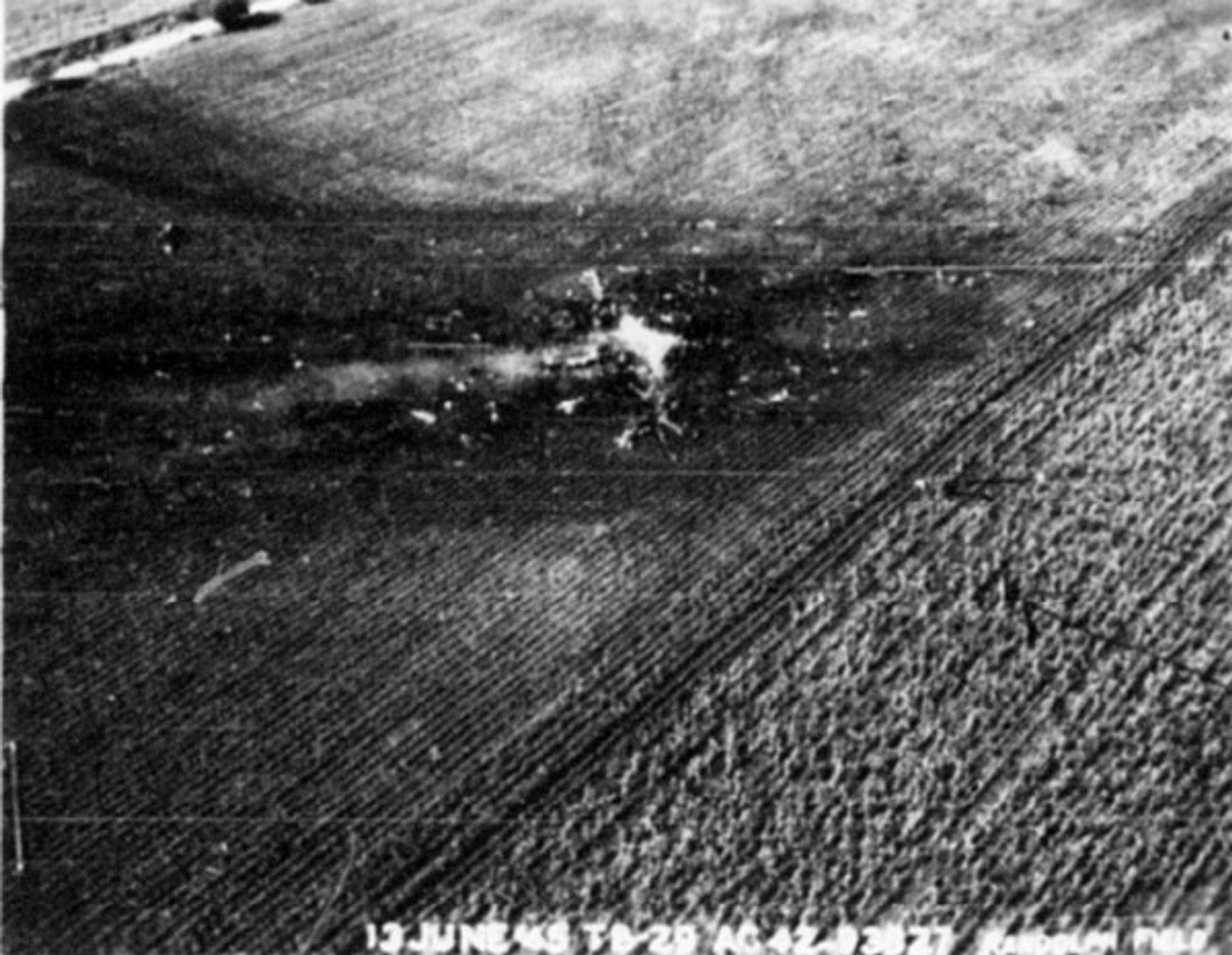
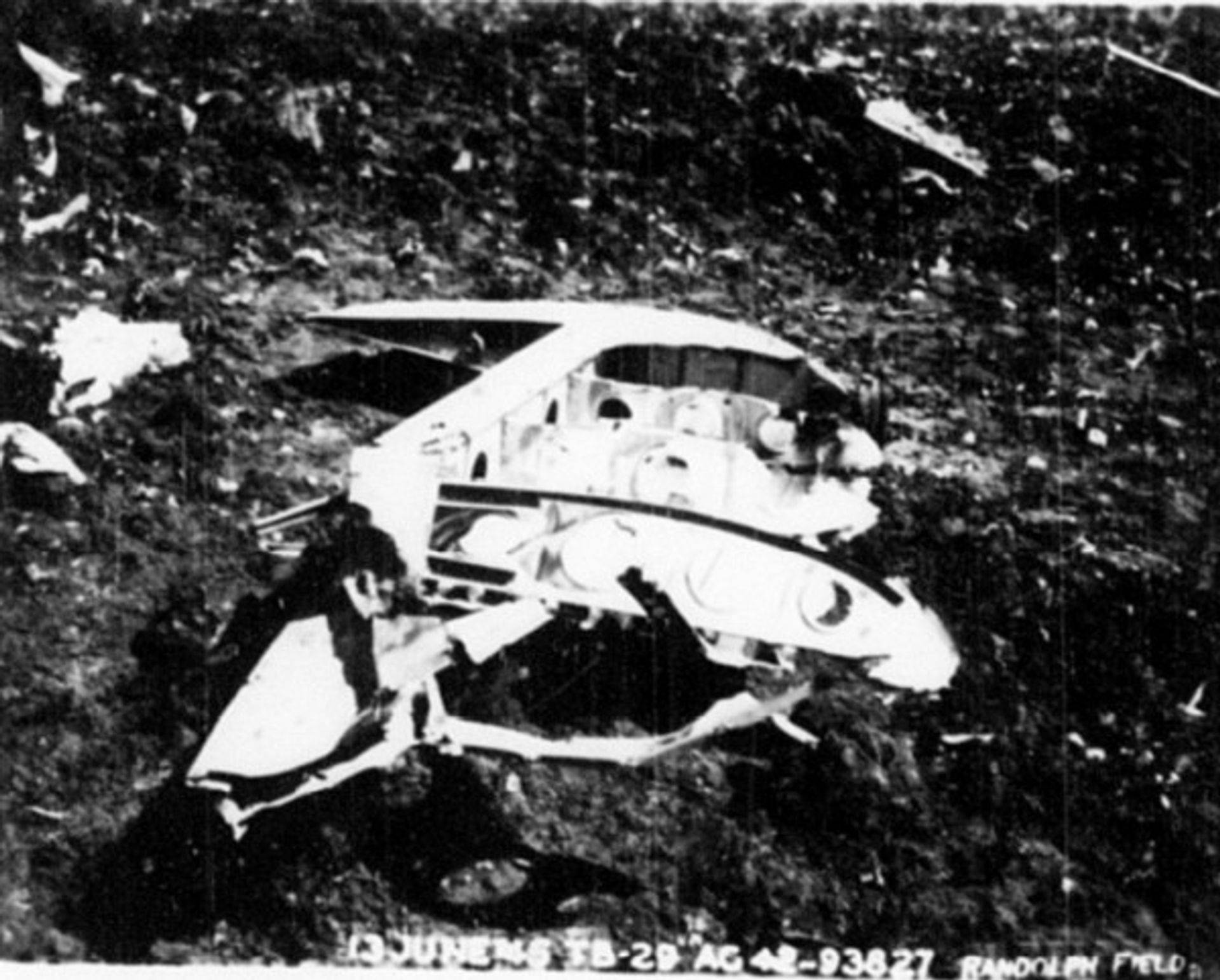
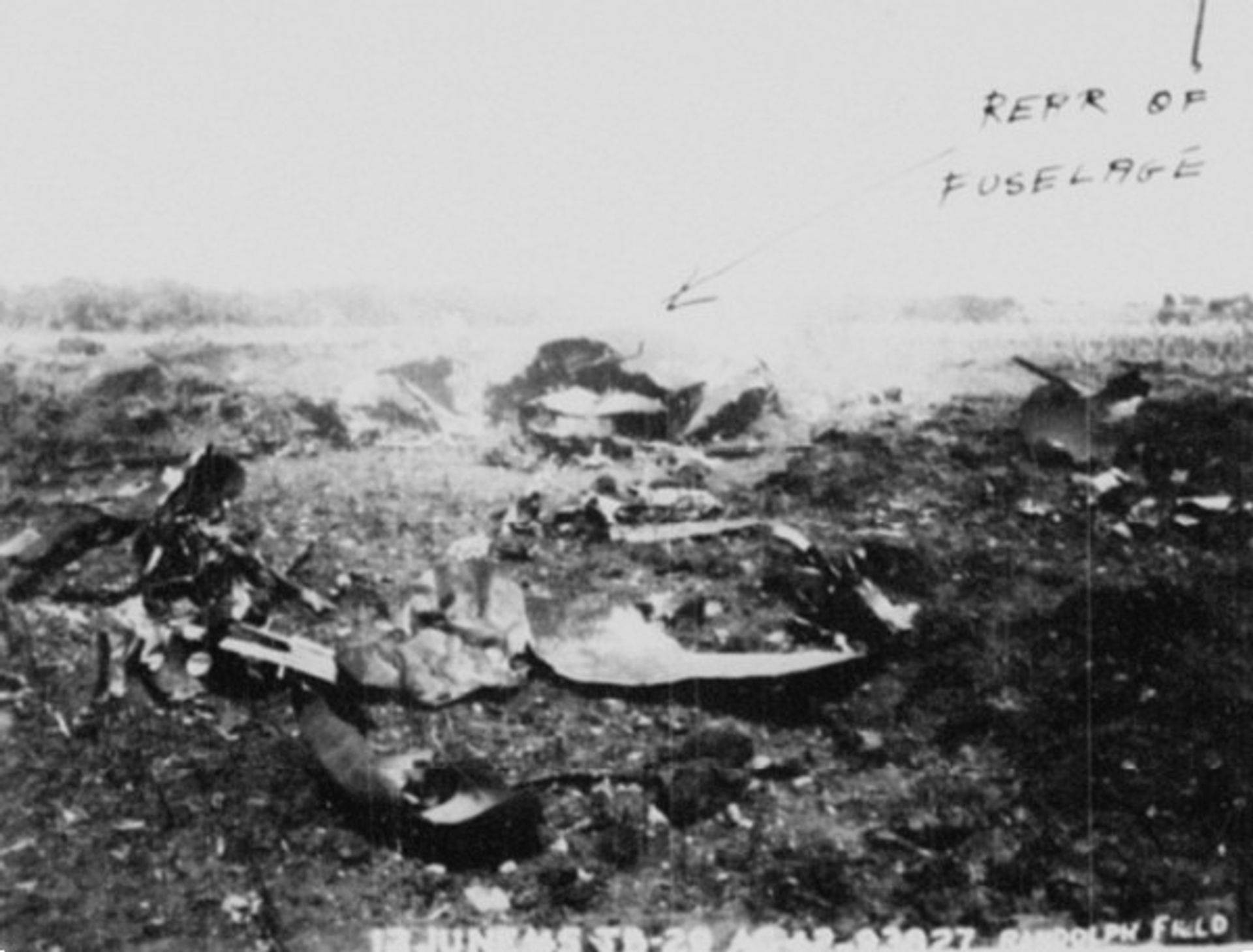
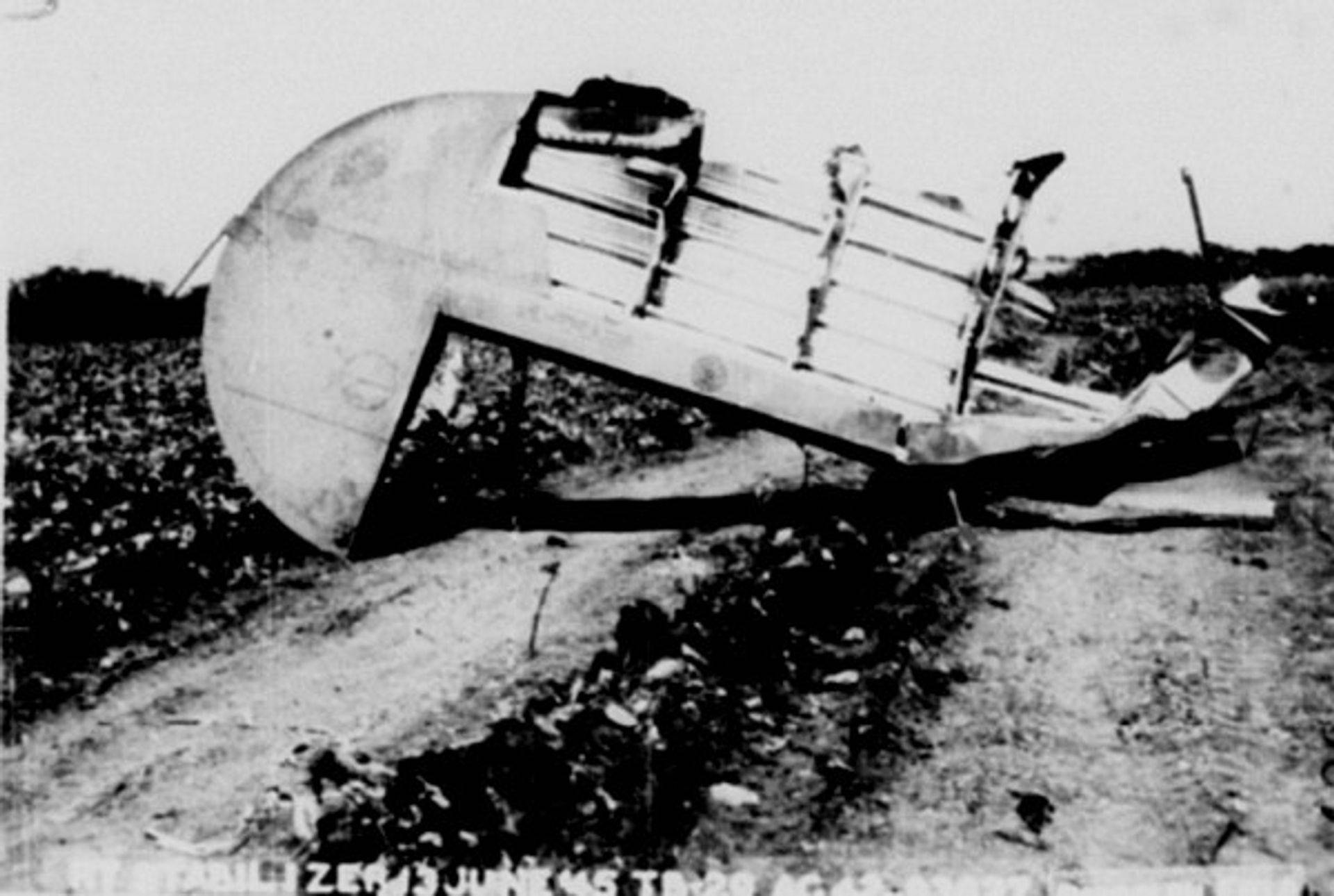
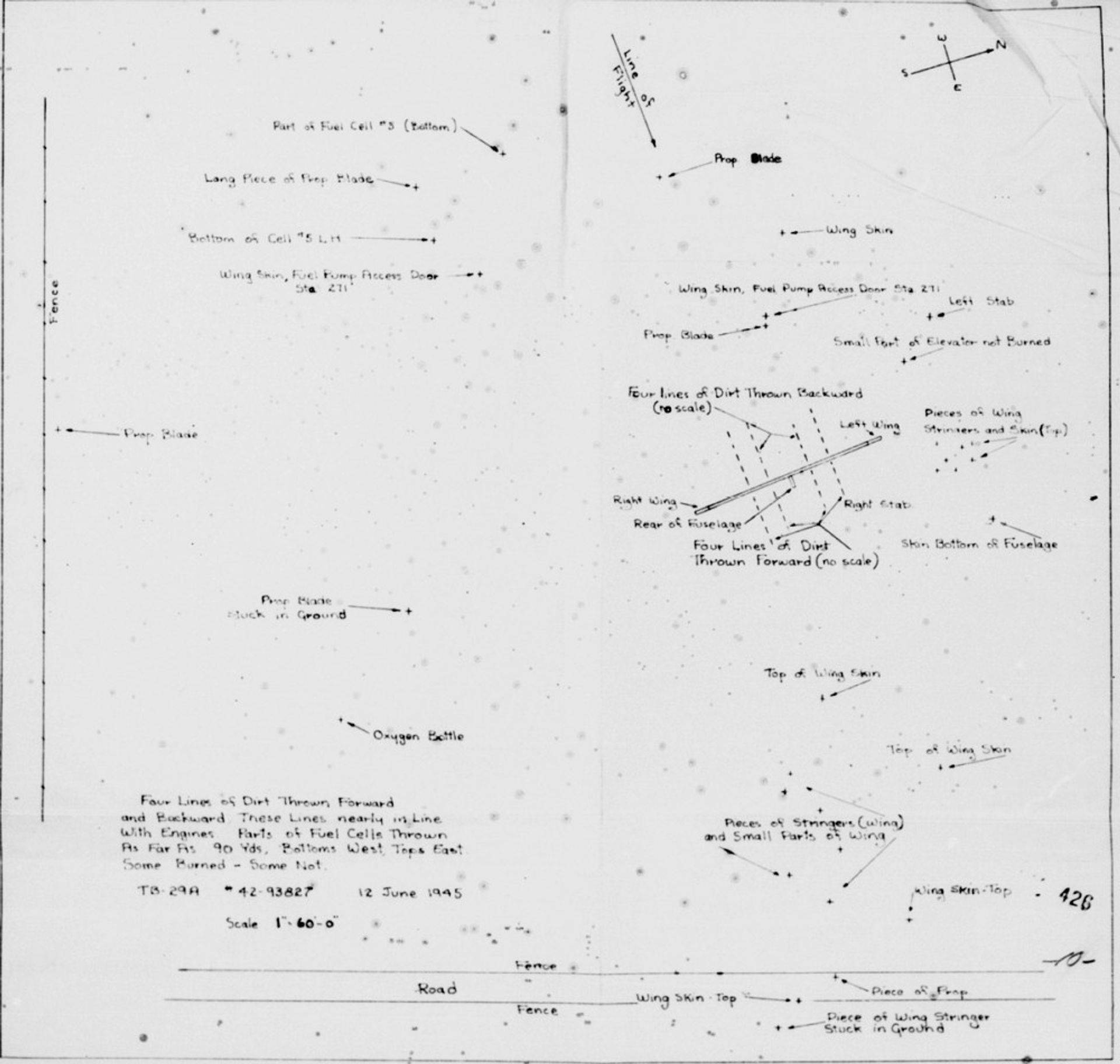
Crash site diagram
